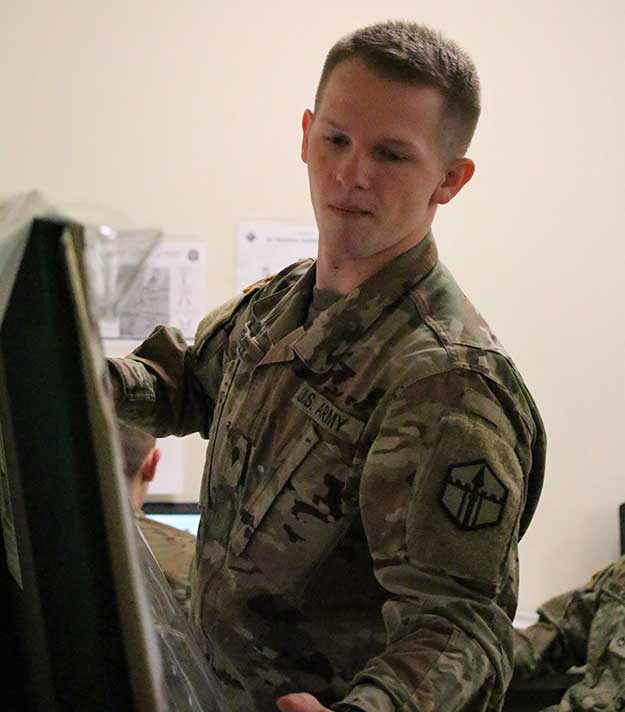(Photo: Spc. Tyler Reninger of Montesano, Washington, updates a map during the 301st Maneuver Enhancement Brigade’s command post exercise-functional event. The 301st MEB is an Army Reserve brigade based at Joint Base Lewis-McChord. It has command and control of three engineer battalions and approximately 2,700 soldiers. The 301st MEB headquarters element conducted the December CPX-F in preparation for an overseas mobilization that will begin sometime next year.)
Staff members of the 301st Maneuver Enhancement Brigade war-gamed a command post exercise-functional (CPX-F) this December. In a simulated tactical operations center, soldiers briefed elaborate graphics on PowerPoint slides, and shared mission products through email and cloud-based services. Lengths of network cables and cords draped their workstations. Multiple monitors stacked each desktop.
Amid the sea of hardware, senior staff members recalled a time before computer processors, when all products were hand-drawn.
 "When I first came in, it was analog maps, radios, telephones, and runners. All your status boards were manual," said Master Sgt. Travis Austin of Tacoma, who acted as the operations non-commissioned officer-in-charge. He joined the Army in 1987 and has served 32 years between the Regular Army, Washington National Guard, and Army Reserve in infantry and military police capacities.
"When I first came in, it was analog maps, radios, telephones, and runners. All your status boards were manual," said Master Sgt. Travis Austin of Tacoma, who acted as the operations non-commissioned officer-in-charge. He joined the Army in 1987 and has served 32 years between the Regular Army, Washington National Guard, and Army Reserve in infantry and military police capacities.
"It's becoming a lost art," Austin said about analog systems.
Throughout the exercise, he tasked his junior soldiers to maintain hard-copies of maps and log-books in preparation for power or network failures. It was a first-time process for Spc. Tyler Reninger, one of Austin's soldiers and a 31B Military Police.
"I've always used the computer," said Reninger. "I've had a cellphone since I was 11."
At 21 years of age, Reninger, of Montesano, is among the youngest soldiers in the 301st MEB. He worked as the exercise's radio transmission operator alongside Spc. Jostin Madsen, 24. Both have grown up in a technological world.
"It's definitely easier with technology," said Spc. Madsen of their job. Madsen, a native of Hughson, California, shared the key role of disseminating battle updates to the staff.
The Army cannot depend on computers alone, according to Austin, whose career has included three combat deployments and service across 10 countries.
"I've been in a situation where we loaded too much on the power grid and tripped the breaker." In such situations, the staff would need to brief from maps and paper, he said.
It is a reality Reninger and Madsen readily acknowledged. They spent the majority of the CPX-F alternating between manning their computer station and updating a large hard-copy map. In comparing the two methods, they remarked that the analog was often simpler.
"Technology can make things difficult when it gets too complex. It takes longer to learn," said Madsen. "It's important to know both the old-school way and the new way."
Over the course of the CPX-F, Madsen and Reninger developed a strong knowledge of the map features, which allowed them to help the staff place transportation routes in the simulated scenarios.
"It's been the best experience," said Reninger about the exercise.
The 301st MEB is an Army Reserve brigade based at Joint Base Lewis-McChord. It has command and control of three engineer battalions and approximately 2,700 soldiers. The 301st MEB headquarters element conducted their December CPX-F in preparation for an overseas mobilization that will begin sometime next year.





Read Comments